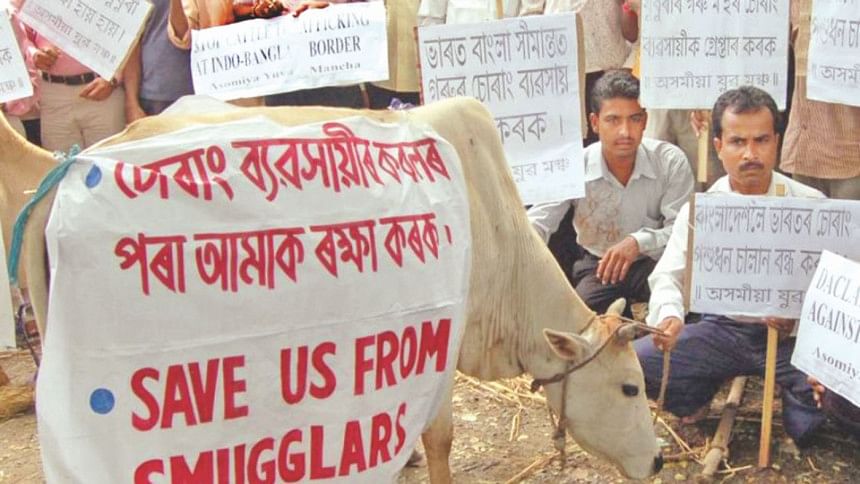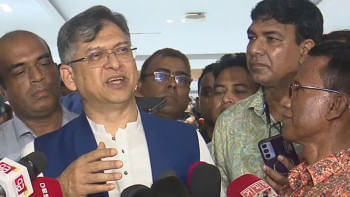How Cow

Every day since time immemorial, perhaps close to one koti students of different levels - from pre-school to doctorate - write essays on 'a cow', but not one of them ever mention India, and yet over the past fortnight, the media has been relentless in doing just that, and not without reason – the cows from across the border have stopped doing the triathlon.
Despite their intelligence being eternally questioned, the Indian cows are adroit enough to survive long distances by road, are great swimmers and, as they make the final few steps across Radcliffe's line, they wink first at the BSF and then smile at the BGB, and land straight into a khatal, where a party unknown to the cattle family pays a fine for each of them, and then they are on their way to abattoirs in Bangladesh.
So what is all the 'how cow' about? Apparently following an Indian home ministry directive early April, and now close to the Muslim festival of Eid-ul-Azha, volunteers of Hindu nationalist group Rashtriya Swayamsevak Sangh (RSS) (the philosophical guru of the ruling Bharatiya Janata Party BJP) have been manning the border to prevent 20 to 25 lakh cows doing the ride-swim-and-walk because cow slaughter has been banned in Modi-dom.
When India denied us our much-needed legitimate river water, they succumbed to the West Bengal logic that water was in short supply across the border, but stopping migration of excess cows defies all rationality. It has been projected by the UN on July 30 that India will become the world's most populous country by 2022, but now this unprecedented how-cow promises to make it also the country with the most cows, maybe even sooner.
The Indian official reason for the ban on cow travel (aka smuggling) is that the cost will become so high that Bangladeshis will be compelled to "give up eating beef." (DS August 26) Fat chance of that. Common economic sense is that when one market closes, the Myanmar channel will expand, as through that avenue, about five thousand cows have already journeyed to Bangladesh.
Also, it requires no financial analyst to imagine that Bangladeshi farmers will be encouraged to rear lakhs of cattle, as the Illegal trade is valued annually anywhere between $600-900 million. We may even have a Cow Bank. With farmers abandoning jute, rice and vegetables crops, Old MacDonald's farm may be sung with a twist, 'Here a cow, there a cow, everywhere a cow cow…'
Prior to slapping the ban, India did not do its arithmetic homework. If the prohibition continues, Indians will have to spend almost Tk. 40,000 crore extra annually to take care of over 12 million cattle till they die naturally, according to The Economic Times. Now that will hurt their farmers because the cows are already there – grazing and grazing and grazing, hamba. . . and more are in the belly.
The Indian leather industry must be prepared to be dependent only on goatskin and their footwear will have to rely more on rubber, plastics, fabrics, etc. Ironically, Bangladesh tanneries claim to be well-stacked and apprehend no immediate shortfall, more so because of the dwindling demand for hide and skin worldwide.
Let us talk sense. India has the cows and cannot slaughter them, nor sell or smuggle. We need over two million cows every year and can pay for them. It is a simple matter of demand and supply. Therefore, a landmark treaty akin to the historic Bangladesh-India land deal needs to be signed and implemented immediately because a 68-year wait, as in the case of the enclaves swap, will be suicidal for the cows as well as the beef-relishing people of Bangladesh.
The two countries will have to declare a 'ceasefire' of sorts that will be effective once every week from dawn to dusk. During the so-called 'truce', BSF and BGB personnel will look away as the cows make their way (winking or not) from across the border to Bangladesh. A part of the 'fine'– about a Tk 1000 per cattle – that was being paid prior to the ban will be shared between the two forces. Everybody smile for the cowfi.
In return favour for the cows, Bangladesh traders will be allowed to transport eelish, Tangail sarees, Porabarir chom-chom, and such deshi goodies, again while the two border forces turn a blind eye, and receive an enabling fine. Dark spectacles shall be recommended as part of the uniform. Who can be a loser in this deed except those not signing on the dotted line?
Another clause of the two-nation pact will be to declare a one-mile deep "No Cow's Land" along the border. For the sake of transparency, during the rest of the week, no cow shall be allowed in the NCL, violation of which will entail doubling of the fine. While this could be profitable, our forces must continue to maintain the highest form of integrity. For the sceptics amongst you, there is no need to call that strip "No hilsa" or "No saree" Land because only cows can walk. Hah! Got you!
The author is a practising Architect at Basha Bari Ltd., a Commonwealth Scholar and a Fellow in the UK, a Baden-Powell Fellow Scout Leader and a Major Donor Rotarian.

 For all latest news, follow The Daily Star's Google News channel.
For all latest news, follow The Daily Star's Google News channel. 



Comments